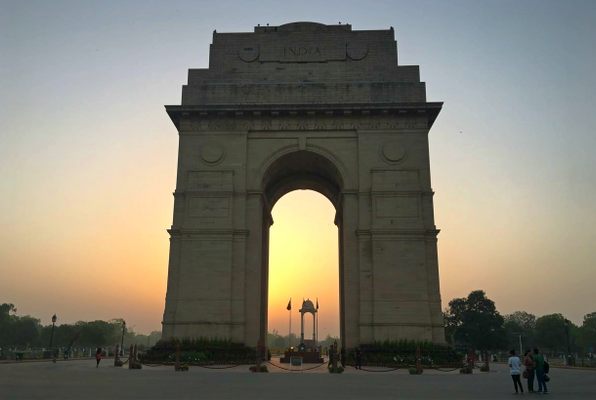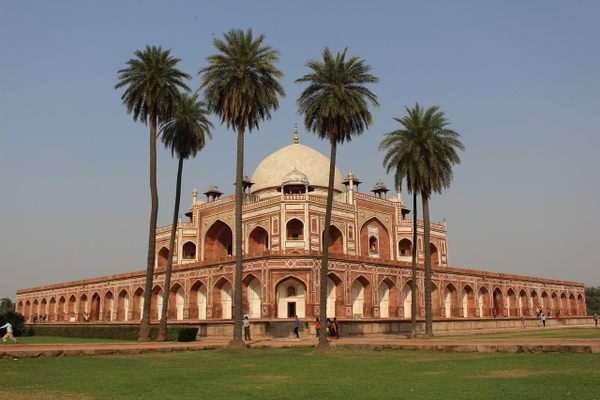About
Visitors to Delhi are usually delighted to be driven around the area of the city known as New Delhi or Lutyens’ Delhi. It’s a vast area of broad, leafy streets and gracious buildings designed by British architect Sir Edwin Lutyens to be the capital of the British Raj, the seat of power for their “Jewel in the Crown.”
The centre point is India Gate, which is bisected by Raj Path—formerly King’s Way—and makes for a very impressive imperial vista. However, the empty cupola that lines up a few meters behind India Gate presents a head-scratching mystery to the uninitiated.
The answer lies in an ancient prophecy: “Whosoever builds a new city in Delhi will lose it.”
Delhi has been the capital city of at least seven or eight great epochs, and probably several more lesser ones. But every conqueror gets conquered and loses the city, some believe due to the prophecy. The British are only the most recent. They declared Delhi the capital of British India in 1911, built a glorious planned city, and lost it in 1947—a mere 36 years of rule from Delhi.
After India declared independence on August 15, 1947, the Indian people pulled down the statue of King George V that had stood in the canopy behind India Gate, and left it empty as mute testimony to their struggle and their victory.
The empty canopy is just one of countless monuments, forts, tombs, and other ruins, scattered throughout the city, that tell the story of Delhi’s many epochs, and point to the truth in the ancient prophecy.
The Mughal dynasty ruled India before the British occupation superseded them in the mid-19th century. Red Fort was once the opulent home and seat of power of the Mughal Emperor Shah Jahan, better known as the builder of the Taj Mahal. He moved the capital to Delhi from Agra and began construction on the Red Fort, a massive citadel that took 10 years to complete, in 1639.
The area around Red Fort, called Shajahanabad, was also developed to include Chandni Chowk, which means “moonlight square.” It was designed by the emperor’s favourite daughter Princess Jahanara Begum, to include a series of canals that reflected moonlight. Today, Red Fort is a UNESCO World Heritage site, and the former glorious capital is called Old Delhi—an area of the city notorious for overcrowded markets, chaotic narrow lanes, dilapidated buildings, and masses of tangled electrical wires that defy believability. Old Delhi is but another example of a lost empire, though the Mughals did hold it for about 200 years until it fell into British hands after the 1857 uprising.
The history of Delhi goes all the way back to the Mahabharata, the great epic of ancient India. The Pandavas cleared an area to establish their kingdom Indraprastha on the banks of the Yamuna river, where Delhi now stands.
Much more recently, between 1100 and 1947, there have been eight capital cities in Delhi—though historians often refer to the “Seven Cities of Delhi.” They are: The oldest city, near the site of the Qutab Minar; Siri; Tughlqabad; Jahanpanah; Firozobad; the city around Purana Qila; Shahjahanabad; and New Delhi.
All of these civilizations have left behind remnants, and three of them are UNESCO World Heritage sites: Qutab Minar, Red Fort, and Humayun’s Tomb. You can visit the Qutab Minar complex, and see the crumbling walls of Siri Fort. Purana Qila is still standing and of course Red Fort and Old Delhi are top tourist attractions. Each one is a living reminder of the ancient prophecy.
As of January 2023: The canopy is no longer empty. A statue of freedom fighter Netaji Subhas Chandra Bose now stands under the canopy.
Related Tags
Know Before You Go
Delhi is the capital city of India.
Delhi and Rajasthan: Colors of India
Discover Colorful Rajasthan: From Delhi to Jaipur and Beyond.
Book NowCommunity Contributors
Added By
Published
February 2, 2018























































